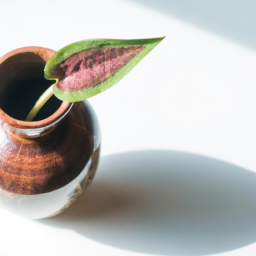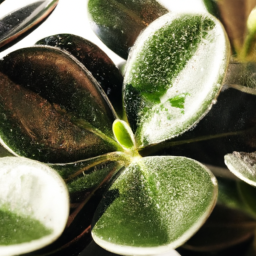
Have you ever tried plant meditation? If not, you’re in for a treat! In this blog post, we’ll explore the wonderful world of plant meditation and how it can help you connect with the greenery around you. Whether you have a green thumb or struggle to keep a cactus alive, plant meditation is a practice that anyone can enjoy. So, grab a cup of tea, find a cozy spot, and let’s dive into the calming and rejuvenating world of plant meditation: connecting with greenery.
The Benefits of Plant Meditation: Exploring the Healing Power of Greenery
Welcome to the world of plant meditation, where connecting with greenery can bring about a multitude of benefits for your mind, body, and soul. In this guide, we will delve into the healing power of greenery and how plant meditation can enhance your overall well-being. So, grab a comfortable seat, breathe in the fresh air, and let’s embark on this journey of self-discovery and tranquility.
Connecting with Nature
Modern life often keeps us disconnected from nature, leading to increased stress levels and a sense of disconnection from our surroundings. Plant meditation offers a way to bridge this gap and reconnect with the natural world. By immersing ourselves in the presence of plants, we tap into the energy and serenity that greenery provides. The vibrant colors, soothing scents, and gentle rustling of leaves create a peaceful ambiance that allows us to unwind and find solace.
When practicing plant meditation, find a quiet spot in your home or a nearby park where you can be surrounded by plants. Sit comfortably and take a few deep breaths, allowing your body to relax and your mind to clear. As you focus your attention on the plants around you, notice their unique shapes, textures, and shades of green. Feel their energy and imagine yourself merging with the natural world, becoming one with the plants.
As you deepen your connection with nature through plant meditation, you may start to experience a sense of calmness and rejuvenation. The stress and worries of everyday life begin to fade away as you immerse yourself in the beauty and tranquility of greenery.
Enhancing Mental Well-being
Plant meditation not only helps us reconnect with nature but also enhances our mental well-being. Numerous studies have shown that spending time in nature and engaging with plants can have a positive impact on our mental health.
One of the key benefits of plant meditation is its ability to reduce stress and anxiety. The presence of plants has a calming effect on our nervous system, helping to lower cortisol levels and promote a state of relaxation. As you engage in plant meditation, you may notice a decrease in racing thoughts and an overall sense of tranquility washing over you.
Moreover, plant meditation can improve our focus and concentration. The act of mindfully observing plants and their intricate details trains our minds to stay present and fully engaged in the moment. This heightened focus can carry over into other areas of our lives, allowing us to be more productive and attentive.
Additionally, plant meditation has been found to boost creativity. The natural beauty and harmonious energy of plants inspire our imagination and open up new pathways for innovative thinking. Whether you’re an artist seeking inspiration or someone looking to think outside the box, plant meditation can provide the mental clarity and creative spark you need.
Nurturing Physical Health
While plant meditation primarily focuses on the mind and soul, its benefits extend to our physical health as well. Greenery has a profound impact on our overall well-being, contributing to a healthier and more vibrant life.
One of the notable physical benefits of plant meditation is improved air quality. Plants act as natural air purifiers, filtering out toxins and releasing fresh oxygen into the environment. Breathing in clean air has a positive effect on our respiratory system, boosting lung function and promoting better overall health. So, by surrounding yourself with plants during meditation, you not only receive their calming energy but also breathe in cleaner air.
Furthermore, studies have shown that spending time in nature can lower blood pressure and reduce the risk of cardiovascular diseases. Plant meditation provides a gentle form of exercise as you sit or walk amidst greenery, which can contribute to a healthier heart and improved circulation. It also encourages outdoor activities, such as gardening or hiking, which promote physical fitness and overall well-being.
Lastly, plant meditation can aid in better sleep. The calming effects of greenery and the fresh oxygen released by plants create an optimal sleep environment. By incorporating plant meditation into your daily routine, you may find that your sleep quality improves, allowing you to wake up feeling refreshed and revitalized.
Conclusion
Plant meditation offers a powerful pathway to connect with nature, improve mental well-being, and nurture physical health. By immersing ourselves in the healing power of greenery, we can find solace, reduce stress, enhance focus, boost creativity, and promote overall wellness. So, take a moment to appreciate the beauty of plants, breathe in their energy, and allow yourself to be transformed by the serenity of plant meditation. Embrace the magic of greenery and let it guide you towards a more balanced and harmonious life.

Plant Meditation: Connecting with Greenery
Techniques for Plant Meditation: How to Connect with Nature’s Energy
Plant meditation is a powerful practice that allows us to connect with nature’s energy and find inner peace. By immersing ourselves in the presence of plants, we can tap into their calming and rejuvenating qualities. In this article, we will explore various techniques for plant meditation that can help you deepen your connection with greenery.
1. Creating a Sacred Space
Before you begin your plant meditation journey, it’s essential to create a sacred space where you can fully immerse yourself in the experience. Find a quiet corner in your home or a peaceful spot in your garden where you can set up your meditation area.
Start by clearing the space of any clutter or distractions. Arrange some cushions or a comfortable chair to sit on. You may also consider adding elements like candles, incense, or crystals to enhance the ambiance. These objects can help create a serene atmosphere and promote relaxation.
Once you have set up your sacred space, bring in a plant or multiple plants that resonate with you. Choose plants that you feel drawn to, whether it’s a lush fern, a vibrant flowering plant, or a simple succulent. The key is to select plants that evoke a sense of calm and harmony within you.
2. Grounding and Centering
Before you dive into your plant meditation practice, it’s important to ground and center yourself. This helps you establish a strong connection with the earth and prepares you to receive the energy of the plants.
Start by taking a few deep breaths, inhaling deeply through your nose and exhaling slowly through your mouth. Feel the breath flowing in and out, allowing yourself to relax and let go of any tension.
Next, visualize roots growing from the soles of your feet, extending deep into the earth. Imagine these roots anchoring you to the ground, providing stability and support. Feel the earth’s energy rising up through your roots, filling your body with a sense of grounding.
Once you feel grounded, bring your attention to your heart center. Visualize a bright light glowing in the center of your chest, radiating love and compassion. Allow this light to expand with each breath, enveloping your entire being.
3. Engaging Your Senses
Now that you are grounded and centered, it’s time to engage your senses and connect with the plants on a deeper level. This step involves observing, touching, smelling, and even tasting the plants if they are edible. Engaging your senses helps to anchor your awareness in the present moment and intensify your connection with nature.
Start by observing the plant’s physical features. Notice the shape, color, and texture of its leaves or petals. Take your time to appreciate its unique beauty and intricacies. You may also observe any changes or movements in the plant, such as the fluttering of leaves in the breeze or the opening of a flower.
Next, gently touch the plant’s leaves or petals, feeling their texture and temperature. Notice how the plant responds to your touch. Is it soft and delicate, or does it have a rougher surface? Engage your sense of touch fully, allowing yourself to be present in the tactile experience.
Bring the plant closer to your nose and take a deep breath, inhaling its natural aroma. Notice any scents or fragrances that emanate from the plant. Allow these scents to awaken your sense of smell and evoke any memories or emotions that may arise.
If the plant is edible and safe to consume, you may choose to taste a small part of it. Be mindful of the plant’s properties and ensure that it is suitable for consumption. Take a small bite and savor the flavors and textures. Notice how the taste of the plant lingers on your palate and how it makes you feel.
Engaging your senses in this way helps to anchor your attention in the present moment and deepens your connection with the plant’s energy.
By following these techniques for plant meditation, you can cultivate a profound connection with nature’s energy and experience a sense of peace and harmony. Remember to approach this practice with an open heart and mind, allowing yourself to be fully present and receptive to the wisdom and healing power of plants.

Creating a Sacred Space for Plant Meditation: Enhancing Your Connection with Greenery
Introduction
Welcome to the world of plant meditation, where you can deepen your connection with nature and experience the profound benefits it offers. In this guide, we will explore the concept of creating a sacred space for plant meditation, allowing you to immerse yourself in the beauty of greenery and harness its transformative power. Whether you are a beginner or an experienced meditator, this step-by-step guide will help you enhance your connection with greenery and unlock the healing potential it holds.
The Importance of a Sacred Space
Before we delve into the practical steps of creating a sacred space, it is essential to understand why it matters. A sacred space serves as a physical and energetic container for your plant meditation practice. It creates an environment that supports relaxation, focus, and connection with nature. By designating a specific area for your practice, you signal to your subconscious mind that it is time to enter a meditative state and connect with the greenery around you.
When you consistently practice in the same space, it becomes energetically charged, making it easier for you to access a meditative state in the future. Additionally, a sacred space allows you to cultivate a sense of reverence and respect for the plant kingdom, fostering a deeper connection and appreciation for the natural world.
Now, let’s explore the step-by-step process of creating your sacred space for plant meditation.
Step 1: Choosing the Right Location
The first step in creating a sacred space for plant meditation is to select the perfect location. Look for an area in your home or garden that resonates with you and feels tranquil. Ideally, it should be a space where you can have privacy and minimal distractions. Consider factors such as natural light, ventilation, and accessibility when choosing your location.
If you prefer an indoor space, find a spot near a window that receives ample sunlight. Natural light not only nourishes your plants but also uplifts your mood and enhances the overall meditative experience. On the other hand, if you prefer an outdoor space, choose a quiet corner in your garden or balcony where you can be in harmony with nature.
Remember, the location you choose should make you feel connected to the greenery around you and provide a sense of peace and tranquility.
Step 2: Clearing and Cleansing the Space
Once you have identified the location, it’s time to clear and cleanse the space. Start by removing any clutter or unnecessary items that may distract you during your meditation. A clean and clutter-free environment promotes a sense of calmness and allows you to focus on your practice.
Next, cleanse the space energetically by smudging with sage, palo santo, or any other cleansing herb of your choice. Light the herb bundle and let the smoke waft through the area, focusing on corners and crevices. As the smoke rises, visualize any stagnant or negative energy being released, creating a purified and harmonious environment for your plant meditation.
Remember to set your intention for the space as you cleanse, inviting positive energy and a deep connection with the greenery.
Step 3: Choosing Plants for Your Sacred Space
The selection of plants plays a vital role in creating your sacred space. Choose plants that resonate with you and evoke a sense of tranquility and connection. Consider plants known for their calming properties, such as lavender, jasmine, or aloe vera. Alternatively, you can opt for plants with lush foliage or vibrant flowers that bring joy and beauty to your space.
When choosing plants, pay attention to their care requirements and ensure they are suitable for the lighting conditions in your chosen location. Select plants that are easy to maintain and align with your level of gardening expertise. Remember, your sacred space should be a nurturing sanctuary, and caring for your plants should be a pleasurable experience.
Consider incorporating a variety of plants with different textures, heights, and colors to create a visually appealing and diverse environment. This diversity will stimulate your senses and deepen your connection with the plant kingdom.
Step 4: Arranging Your Sacred Space
Now that you have chosen your location and plants, it’s time to arrange your sacred space. Start by placing a comfortable cushion or mat on the floor, creating a designated area for your meditation practice. This cushion will serve as your anchor, providing physical comfort and grounding during your sessions.
Position your plants strategically around the cushion, creating a harmonious and balanced arrangement. Consider the visual aesthetics as well as the energetic flow of the space. You may choose to place taller plants at the back and smaller ones in the front, or arrange them in a circular pattern to symbolize the cyclical nature of life.
Enhance the ambiance of your sacred space by incorporating natural elements such as stones, shells, or crystals that resonate with you. These elements can amplify the energy and create a deeper connection with nature.
Step 5: Setting the Mood
Now that your sacred space is arranged, it’s time to set the mood for your plant meditation practice. Consider the following elements to create a serene and inviting atmosphere:
Lighting: Adjust the lighting to create a soft and soothing ambiance. You can use candles, fairy lights, or dimmable lamps to create a warm and gentle glow.
Aromatherapy: Incorporate essential oils or natural incense to infuse the air with calming scents. Lavender, eucalyptus, or sandalwood are excellent choices for promoting relaxation and focus.
Soundscapes: Play gentle nature sounds, instrumental music, or guided meditation tracks to enhance the meditative experience. The soothing sounds will transport you to a state of tranquility and deepen your connection with greenery.
Personal Touches: Add personal items such as photographs, artwork, or meaningful objects that evoke positive emotions and memories. These personal touches will further enhance your connection with your sacred space.
Conclusion
Congratulations! You have now created a sacred space for plant meditation, enhancing your connection with greenery and inviting the transformative power of nature into your life. Remember, this space is a sanctuary for your mind, body, and soul. Regularly spend time in your sacred space, practicing plant meditation, and nurturing your connection with the plant kingdom. As you deepen your relationship with greenery, you will experience profound healing, relaxation, and a renewed sense of harmony with the natural world.
Embrace this journey of plant meditation and allow the beauty of greenery to guide you towards inner peace and serenity.
In Summary
Have you ever felt a deep sense of calm and serenity when surrounded by nature? The vibrant hues of green, the gentle rustling of leaves, and the earthy scent of the soil can transport us to a place of tranquility. Plant meditation, a practice that involves connecting with greenery, allows us to tap into this profound connection and experience the healing power of plants.
In a world filled with constant distractions and digital overload, plant meditation offers a much-needed respite. It encourages us to slow down, be present, and immerse ourselves in the beauty of the natural world. Whether you have a garden, a balcony filled with potted plants, or simply a nearby park, you can embark on this journey of self-discovery and rejuvenation. By focusing our attention on plants, we can cultivate a deep connection with them, allowing their energy to flow through us and bring about a sense of peace and harmony. So, the next time you find yourself in need of a mental escape, take a moment to sit amongst the greenery, breathe in the fresh air, and let the plants guide you on a journey of self-reflection and renewal.
Your Questions Answered. Comprehensive FAQ:
Q1: What is plant meditation?
A1: Plant meditation is a practice where individuals connect with nature and specifically plants to find inner peace, relaxation, and a deeper sense of connection with the natural world. It involves focusing your attention on plants, their beauty, and their energy, allowing yourself to be fully present in the moment.
Q2: How does plant meditation work?
A2: Plant meditation works by immersing yourself in the presence of plants and engaging your senses. Find a quiet spot near greenery, whether it’s a garden, park, or even your own houseplants. Sit comfortably, take deep breaths, and observe the plants around you. Notice their colors, textures, and shapes. Feel the air, listen to the sounds of nature, and let your mind and body relax in their presence.
Q3: What are the benefits of plant meditation?
A3: Plant meditation offers various benefits for both mental and physical well-being. It helps reduce stress, anxiety, and negative emotions by promoting relaxation and a sense of calm. Connecting with greenery can improve mood, increase focus, and enhance creativity. It also strengthens the bond with nature, fostering a greater appreciation for the environment and our interconnectedness with it.
Q4: Can anyone practice plant meditation?
A4: Absolutely! Plant meditation is accessible to anyone, regardless of age, experience, or physical abilities. You don’t need any special skills or knowledge. Simply find a place with plants, set aside some time, and be open to the experience. Whether you’re a beginner or an experienced meditator, plant meditation can be a wonderful practice to incorporate into your routine.
Q5: How can I incorporate plant meditation into my daily life?
A5: There are several ways to incorporate plant meditation into your daily life. You can set aside dedicated time each day to sit with plants and meditate. Alternatively, you can integrate it into your existing routines, such as taking mindful walks in nature, tending to your garden, or even spending a few moments appreciating the plants in your home. The key is to make it a regular practice and allow yourself to fully immerse in the beauty and energy of greenery.
Dr. Olivia Green is a botanist with over two decades of experience in indoor plant cultivation. She holds a Ph.D. in Plant Biology and has dedicated her career to researching plant behavior in controlled environments. Dr. Green is passionate about helping plant enthusiasts master the art of indoor gardening through her extensive knowledge and practical insights.


